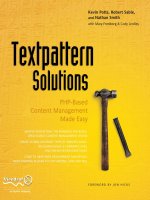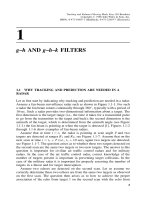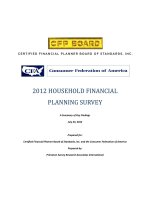Nonprofit financial planning made easy
Bạn đang xem bản rút gọn của tài liệu. Xem và tải ngay bản đầy đủ của tài liệu tại đây (1.35 MB, 259 trang )
NONPROFIT FINANCIAL
PLANNING MADE EASY
Jody Blazek, CPA
John Wiley & Sons. Inc.
ffirs.indd iiiffirs.indd iii 12/13/07 12:56:56 PM12/13/07 12:56:56 PM
ffirs.indd iiffirs.indd ii 12/13/07 12:56:56 PM12/13/07 12:56:56 PM
NONPROFIT FINANCIAL
PLANNING MADE EASY
ffirs.indd iffirs.indd i 12/13/07 12:56:56 PM12/13/07 12:56:56 PM
ffirs.indd iiffirs.indd ii 12/13/07 12:56:56 PM12/13/07 12:56:56 PM
NONPROFIT FINANCIAL
PLANNING MADE EASY
Jody Blazek, CPA
John Wiley & Sons. Inc.
ffirs.indd iiiffirs.indd iii 12/13/07 12:56:56 PM12/13/07 12:56:56 PM
This book is printed on acid-free paper.
Copyright © 2008 by John Wiley & Sons, Inc. All rights reserved.
Published by John Wiley & Sons, Inc., Hoboken, New Jersey.
Published simultaneously in Canada.
No part of this publication may be reproduced, stored in a retrieval system, or
transmitted in any form or by any means, electronic, mechanical, photocopying,
recording, scanning, or otherwise, except as permitted under Section 107 or 108 of
the 1976 United States Copyright Act, without either the prior written permission
of the Publisher, or authorization through payment of the appropriate per-copy fee
to the Copyright Clearance Center, Inc., 222 Rosewood Drive, Danvers, MA 01923,
978-750-8400, fax 978-646-8600, or on the web at www.copyright.com. Requests to
the Publisher for permission should be addressed to the Permissions Department,
John Wiley & Sons, Inc., 111 River Street, Hoboken, NJ 07030, 201-748-6011, fax
201-748-6008, or online at />Limit of Liability/Disclaimer of Warranty: While the publisher and author have
used their best efforts in preparing this book, they make no representations
or warranties with respect to the accuracy or completeness of the contents of
this book and specifically disclaim any implied warranties of merchantability
or fitness for a particular purpose. No warranty may be created or extended
by sales representatives or written sales materials. The advice and strategies
contained herein may not be suitable for your situation. You should consult with
a professional where appropriate. Neither the publisher nor author shall be liable
for any loss of profit or any other commercial damages, including but not limited
to special, incidental, consequential, or other damages.
For general information on our other products and services, or technical support,
please contact our Customer Care Department within the United States at
800-762-2974, outside the United States at 317-572-3993 or fax 317-572-4002.
Wiley also publishes its books in a variety of electronic formats. Some content that
appears in print may not be available in electronic books.
For more information about Wiley products, visit our Web site at
.
Library of Congress Cataloging-in-Publication Data:
Blazek, Jody.
Nonprofit financial planning made easy/Jody Blazek.
p. cm.—(Wiley nonprofit law, finance, and management series)
Includes bibliographical references and index.
ISBN 978-0-471-71527-6 (pbk.)
1. Nonprofit organizations—Finance. 2. Nonprofit organizations—
Accounting. 3. Nonprofit organizations—Management. I. Title
HG4027.65.B553 2008
658.15 —dc22
2007044832
Printed in the United States of America
10 9 8 7 6 5 4 3 2 1
ϱϱ
ffirs.indd ivffirs.indd iv 12/13/07 12:56:57 PM12/13/07 12:56:57 PM
v
Contents
Exhibits xi
About the Author xv
Preface xvii
Chapter 1: Introductory Concepts 1
How to Use this Book 3
Attributes of Nonprofi ts 6
Can Nonprofi ts Profi t? 8
Meaning of Profi t 8
Profi t Prohibitions 9
Why Seek a Profi t? 10
Difference Between Nonprofi ts and For-Profi ts 11
Capitalization: Philanthropists versus Investors 11
Revenues: Constituents versus Customers 12
For-Profi t Tools 13
Pursuit of Financial Success: Some Observations 14
Be Realistic about Expectations 14
Make Use of Intangible Resources 14
Nonprofi t Mentality Is Often “Penny Wise and
Pound Foolish” 15
Financial Accounting for Nonprofi ts Is Different 15
Producing an Audit Trail Benefi ts the Organization
in Many Ways 16
Enhancing Computer Capabilities May Not Cure
Financial Ills 16
Respect the Organizational Structure or Change It 17
ftoc.indd vftoc.indd v 12/13/07 8:29:33 PM12/13/07 8:29:33 PM
vi Contents
Know Who’s in Charge 17
Economic Conditions Must Be Anticipated 18
Long-Range Planning Is Indispensable 18
Know Why the Nonprofi t Organization Has
Tax-Exempt Status 18
Comprehensive Financial Planning Checklist 19
Chapter 2: Structuring the Organization for Fiscal Strength 27
Establishing the Hierarchy 30
The Role of the Board 31
Standards for Directors 31
Impact of Sarbanes-Oxley 33
A Director’s Duties 34
Reviewing Financial Reports 37
Filling Board Positions 39
Finding Prospects 40
Staff Representation on the Board 40
Compensation for Board Service 41
Number of Directors 42
Roles of The Treasurer and The CFO 42
Inside and Outside Accountants 42
Financial Management Team 45
Defi ning Inside and Outside Accountants 45
Selecting Financial Reporting Services 46
Understanding the Auditing Process 46
When to Audit 48
Review and Compilation Processes 48
Requests for Proposals for Accounting Services 49
Confl ict-of-Interest Policy 50
Chapter 3: Financing the Dream 57
Balancing Mission and Finances 57
Defi ning the Mission 59
Mission Statement 59
Prioritizing Goals 60
Assessing the Resources 61
Making Micro Resource Decisions 61
Macro Resource Analysis 62
Chapter 4: Budgeting 67
Budget-Planning Issues 67
Balancing 68
Timing 68
Evolution 68
Accountability 69
ftoc.indd viftoc.indd vi 12/13/07 8:29:34 PM12/13/07 8:29:34 PM
Contents vii
Zero Basis versus Incremental 69
Forecasting 70
Types of Budgets 70
Advantages and Disadvantages 71
Who Participates in Budgeting? 72
Selling the Budget 73
Budget Policy Manual 73
Communicating the Process 74
Scheduling Budget Process 75
Changing Budget Midyear 76
Timing Dilemmas 77
Preparing Forecasts 77
Donations and Memberships 78
Service Delivery Fees 79
Grants and Contracts 79
Investment Income 79
Expenses 80
Statistical Operational Data 81
Sample Customer Survey 82
Useful Statistics 83
Capital Additions Budget 85
Monitoring Variances 86
Model Budgets 86
Proposed Overall 20XX Budget Compared
to 20XX Actual 87
Functional Revenue and Expense Budget 88
Member Services Budget Worksheet 88
Budget Increases (Decreases) Projected
for 20XX 91
Personnel Budget 92
Program Cost Analysis 92
Other Reports and Analysis 94
A Budgeting Checklist 96
Chapter 5: Asset Management 101
Maximizing Resources 101
Getting Resources 103
Forming Alliances 104
Business Income 105
Planned Gifts 106
Cash Flow Planning 107
Understanding CPAs’ Cash Flow Statements 107
Cyclical Fluctuations 109
Designing Cash Flow Budgets 109
Beyond Cash Flow Imbalances 117
ftoc.indd viiftoc.indd vii 12/13/07 8:29:34 PM12/13/07 8:29:34 PM
viii Contents
More Money in the Bank 117
To Borrow or Not 118
Prudent Investment Planning 118
Facing the Unknown 121
Risk versus Return 124
Investment Cycles 125
Measuring Investment Return 126
Restricted Gifts 128
Isolating Restricted Grants 128
Administrative Costs 128
Endowments 129
Who Gets the Appreciation? 130
To Mark It to Market? 131
How Income Is Measured 132
Endowment and Restricted Fund Checklist 133
Chapter 6: Nonprofi t Accounting 137
What is Accounting? 137
Cash Receiving Systems 139
Cash Disbursement Systems 140
Payroll Disbursement System 140
Other Useful Ledgers and Financial Files 141
Fund Accounting 145
Computerized Accounting 146
Chart of Accounts 149
National Standard 149
Functional Expense Categories 149
Why a Double Entry? 154
Choosing a Method 161
Advantages of Cash Method 161
Why Use the Accrual Method? 161
Design of the Financials 162
FASB, GAAP, and Nonprofi ts 164
Specifi c Standards for Nonprofi ts 164
Other Nonprofi t Reporting 166
Internal Controls 167
Chapter 7: Special Financial Tools 179
Financial Indicators to Critique Performance 179
Economies of Scale 185
Break-Even Analysis 186
Performance Statistics 186
Cost Accounting 186
ftoc.indd viiiftoc.indd viii 12/13/07 8:29:34 PM12/13/07 8:29:34 PM
Contents ix
Techniques for Capturing Costs 187
Cost Allocation Methods 189
Purchasing Procedures 190
Approval Systems 191
How Much Paperwork? 192
Measuring Lifetime Cost 194
To Lease or to Buy 195
Affi liations and Agency Agreements 197
Who’s an Employee? 201
Chapter 8: Obtaining and Maintaining Tax-Exempt Status 207
Characteristics of Tax-Exempt Organizations 208
Theoretical Basis for Exemption 208
Categories of Exemption 208
Tax Deductibility 211
Understanding the Nonprofi t’s Legal Form 211
Corporation 212
Trust 213
Unincorporated Association 213
Testing Suitability For Tax Exemption 214
Why a New Nonprofi t? 214
What Category of Exemption? 214
How Is Money to Be Raised? 215
Will Insiders Benefi t? 215
Where Will Assets Go? 216
Maintaining Recognition of Exempt Status 218
Role of Internal Revenue Service 219
Forms 990 220
Other Filings 221
Resources 223
Index 227
ftoc.indd ixftoc.indd ix 12/13/07 8:29:35 PM12/13/07 8:29:35 PM
ftoc.indd xftoc.indd x 12/13/07 8:29:35 PM12/13/07 8:29:35 PM
xi
EXHIBITS
Exhibit 1.1 Financial Management Activities in Nonprofi t
Organizations 5
Exhibit 1.2 Financial Planning Checklist for Nonprofi t
Organizations 19
Exhibit 2.1 State Association of Nonprofi t Managers
Organization Chart 28
Exhibit 2.2 Endowed Educational Institution Investment
Management Organization 28
Exhibit 2.3 SHAPE Organizational Structure for Stabilization
and Preservation 29
Exhibit 2.4 A Board Member’s Checklist of Fiduciary Duties 35
Exhibit 2.5 Inventory of Financial Reports 38
Exhibit 2.6 Roles of the Treasurer and the Chief Financial
Offi cer 43
Exhibit 2.7 Request for Proposal for Audit 49
Exhibit 2.8 Confl ict-of-Interest Questionnaire for
Board Members 51
Exhibit 2.9 IRS Version of Confl ict-of-Interest Policy 52
Exhibit 3.1 Financial Planning Cycles 58
Exhibit 3.2 The Balance Between the Mission and
Financial Resources 59
Exhibit 3.3 Prioritizing Organizational Objectives 60
Exhibit 3.4 Chart for Weighing Choices: Financial Solutions
for Tight Budgets 63
Exhibit 3.5 Holy Spirit Church Statement of Financial Position
(December 31, 20XX) 64
Exhibit 3.6 Prioritizing Macro Resource Goals 65
ftoc.indd xiftoc.indd xi 12/13/07 8:29:35 PM12/13/07 8:29:35 PM
Exhibit 4.1 Who Works on the Budget When? 73
Exhibit 4.2 Interoffi ce Memo on Annual Budgeting 74
Exhibit 4.3 Resource Assessment Checklist 82
Exhibit 4.4 Service Delivery Evaluation 83
Exhibit 4.5 Typical Nonprofi t Organization Membership History 84
Exhibit 4.6 Proposed Overall Budget Compared to Actual 87
Exhibit 4.7 Functional Revenues and Expense Budget 89
Exhibit 4.8 Member Services Budget Worksheet 90
Exhibit 4.9 Budgeted Increases (Decreases) Projected for 20XX 91
Exhibit 4.10 Personnel Budget 93
Exhibit 4.11 Program Cost Analysis 93
Exhibit 4.12 Capital Acquisition Budget 94
Exhibit 4.13 Insurance Coverage Report 95
Exhibit 4.14 Short-and Long-Term Budgeting Checklist 96
Exhibit 5.1 Resource Flow for Business League 102
Exhibit 5.2 Resource Flow for Academic Institution 103
Exhibit 5.3 Statement of Cash Flows for the Year 20XX 108
Exhibit 5.4 Business League’s Cash Flow, Version 1 110
Exhibit 5.5 Business League’s Cash Flow, Version 2 112
Exhibit 5.6 State Association of Nonprofi t Managers Version 1:
Charted Cash Flow 114
Exhibit 5.7 State Association of Nonprofi t Managers Version 2:
Charted Cash Flow 114
Exhibit 5.8 Church Cash Flow 115
Exhibit 5.9 Investment Alternatives 122
Exhibit 5.10 Classic Investment Ratios 123
Exhibit 5.11 Investment Risk Pyramid 125
Exhibit 5.12 Investment Phases 126
Exhibit 5.13 Endowment and Restricted Fund Checklist 133
Exhibit 6.1 Bookkeeping and Accounting Process 138
Exhibit 6.2 Minimal Financial Record Keeping for a Nonprofi t
Organization 143
Exhibit 6.3 Selecting Suitable Accounting Software 147
Exhibit 6.4 Standard Chart of Accounts 150
Exhibit 6.5 Functional Classifi cation of Expenses 154
Exhibit 6.6 Sample Accrual Basis Financials for Business League 155
Exhibit 6.7 Sample Cash-Basis Financials for a Church 158
Exhibit 6.8 Internal Controls for Nonprofi ts 168
Exhibit 6.9 Public Fund Solicitation Controls 177
Exhibit 7.1 Using Ratio Analysis to Test Fiscal Health 180
Exhibit 7.2 Hometown Education Center: Purchase Procedure
Reference Chart 191
Exhibit 7.3 Hometown Education Center: Petty Cash
Reimbursement Request 192
Exhibit 7.4 Hometown Education Center: Petty Cash Log 192
xii Exhibits
ftoc.indd xiiftoc.indd xii 12/13/07 8:29:35 PM12/13/07 8:29:35 PM
Exhibit 7.5 Hometown Education Center: Petty Cash Request 193
Exhibit 7.6 Hometown Education Center: Purchase Order
#___________ 193
Exhibit 7.7 Hometown Education Center: Major Purchase
Planning Matrix 194
Exhibit 7.8 Deciding Whether to Lease or Buy 195
Exhibit 7.9 Sample Fundraising Event Sponsorship Agreement 198
Exhibit 7.10 Sample Fiscal Sponsorship Agreement 199
Exhibit 7.11 Sponsor or Agency Record-Keeping Requirements 201
Exhibit 7.12 Employer Tax Checklist 202
Exhibit 7.13 Employee versus Independent Contractor Status:
A Comparison Checklist 204
Exhibit 7.14 Minimal Independent Contractor Agreement 206
Exhibit 8.1 Suitability Checklist for Tax-Exempt Status 216
Exhibit 8.2 Annual Tax-Filing Requirements for Nonprofi t
Organizations 221
Exhibits xiii
ftoc.indd xiiiftoc.indd xiii 12/13/07 8:29:35 PM12/13/07 8:29:35 PM
ftoc.indd xivftoc.indd xiv 12/13/07 8:29:36 PM12/13/07 8:29:36 PM
xv
About the Author
Jody Blazek is a partner in Blazek & Vetterling LLP, a Houston CPA fi rm
focusing on tax and fi nancial services for exempt organizations and the
individuals who create, fund, and work with them. BV provides tax compli-
ance, auditing, and planning services to over 500 nonprofi t organizations,
including schools, churches, museums, human service organizations, busi-
ness leagues, private foundations, garden clubs, fraternities, research insti-
tutes, civic associations, cultural organizations, and others.
Jody began her professional career at KPMG, then Peat, Marwick,
Mitchell & Co. Her concentration on exempt organizations began in 1969,
when she studied and advised clients about the Tax Reform Act that com-
pletely revamped the taxation of charities and created private foundations.
From 1972 to 1981, she gained nonprofi t management experience as treas-
urer of the Menil Interests, where she worked with John and Dominique de
Menil to plan the Menil Collection, the Rothko Chapel, and other projects
of the Menil Foundation. She reentered public practice in 1981 to found the
fi rm she now serves.
She is the author of six books in the Wiley Nonprofi t Series: IRS Form
1023 Preparation Guide (March, 2005), IRS Form 990 Tax Preparation Guide
for Nonprofi ts (2001, online version, 2004), Tax Planning and Compliance for
Tax - Exempt Organizations, 4th edition (2004), Financial Planning for Nonprofi t
Organizations (1996), Private Foundations: Tax Law and Compliance, 2nd edition
(2003), and The Legal Answer Book for Private Foundations (2001), coauthored
with Bruce R. Hopkins.
Jody serves on the Financial Accounting and Transparency Group cre-
ated by Independent Sector to support the Panel on the Nonprofi t Sector ’ s
reports to the Senate Finance Committee. For that project, she also works
with Foundation Financial Offi cers ’ Group to provide technical assistance
and support to the Form 990 - PF Reform Committee.
fbetw.indd xvfbetw.indd xv 12/13/07 12:56:01 PM12/13/07 12:56:01 PM
She is past chair of the AICPA Tax - Exempt Organizations Resource
Panel and a member of the 990 and 1023 Task Forces. She serves on the
national editorial board of Tax Analysts ’ The Exempt Organization Tax
Review. She serves on the Community Service Committee of the Houston
Chapter of Certifi ed Public Accountants and is a founding director of Texas
Accountants and Lawyers for the Arts and the Houston Artists Fund. She is
a member of the board of the Gulf Coast Institute, the Anchorage Founda-
tions, and the Main Street Coalition Council. She is a frequent speaker at
nonprofi t symposia, including those sponsored by the Conference of South-
west Foundations; Association of Small Foundations; AICPA; Arizona, New
York, Washington, Maryland, and Texas Societies of CPAs; the University of
Texas School of Law; United Way of the Texas Gulf Coast; Professional Edu-
cation Systems, and Nonprofi t Resource Center, among others.
Jody received her BBA from the University of Texas at Austin in 1964
and took selected tax courses at South Texas School of Law. She and her
husband, David Crossley, nurture two sons, Austin and Jay Blazek Crossley.
xvi About the Author
fbetw.indd xvifbetw.indd xvi 12/13/07 12:56:01 PM12/13/07 12:56:01 PM
xvii
Preface
Financial planning contributes significantly to the success of a nonprofit
organization and allows it to better accomplish its mission. Planning tasks
are challenging and too often are overlooked. In this time of shrinking
governmental support for nonprofit organizations, astute use of available
resources following a well - developed financial plan may be the key to a
nonprofit ’ s survival.
The concepts and techniques presented in this book can simplify the
efforts of fi nancial managers and board members to be fi scally responsible,
or accountable, to the organization ’ s private and governmental funders, to
its clients, to the community in which it operates, and to the society benefi t-
ing from its work.
The nonprofi t world to a great extent embodies selfl ess groups of per-
sons working to help others in a wide context. The groups through which
they work are clustered in three distinct types:
1. Charitable organizations: churches, soup kitchens, universities, muse-
ums, and research institutes.
2. Associations and community organizations: civic leagues, business
leagues, labor unions, and social clubs.
3. Public sector: governments, municipalities, agencies, and public
boards that work with nonprofits.
Hopefully, many people working in this broad range of nonprofi ts will
fi nd in this book a good prescription for their organization ’ s fi scal health.
My experiences as an accountant serving nonprofi t organizations
inspired me to develop checklists and forms to encourage the use of fi nancial
fpref.indd xviifpref.indd xvii 12/13/07 12:57:26 PM12/13/07 12:57:26 PM
planning. When my fi rm is engaged to perform traditional accounting
services for a nonprofi t organization, such as preparation of the annual
Form 990 or performance of an annual audit, we often fi nd that the organi-
zation needs fi nancial management assistance beyond the specifi c task we
are engaged to perform. Also, when our help is sought to help overcome
unexpected fi nancial problems, we often fi nd the nonprofi t managers could
have averted the crisis with adequate advanced planning.
In Chapter 1 , I seek to dispel myths that can hamper a nonprofi t ’ s
fi nancial success. Nonprofi ts can profi t, or accumulate revenues in excess of
expenditures, so long as such resources are devoted to improving the fashion
in which the nonprofi t accomplishes its exempt purposes. While surpluses
shouldn ’ t exceed that amount reasonably needed to assure fi nancial stability,
funds can be saved to fi nance future plans. A nonprofi t can set aside funds
to expand programs, self - insure risks, build a new building, establish a new
location, or simply provide adequate working capital. The primary distinc-
tion between a for - profi t and a nonprofi t is that the latter has no owners. The
nonprofi t does not distribute its profi ts, if any, to any private individuals — its
creators, insiders, or those who govern it. It can, however, and should accu-
mulate suffi cient working capital from surplus income to assure uninter-
rupted and viable program delivery.
In pursuit of fi nancial stability, a nonprofi t can conduct its fi nancial
affairs in a business - like fashion as long as its managers understand the ways
in which it is different from a for - profi t business. Both need strategic plans
based on clearly defi ned goals, with a focus on accountability, productivity,
and profi tability. To be fi scally successful, both need skilled fi nancial man-
agers. In evaluating a nonprofi t ’ s staffi ng budgets, it is interesting and can
be useful to observe whether the organization considers fi nancial personnel
equally as important as its program offi cers. Seeking pro bono volunteer
fi nancial services is not always cost effective in the long run.
The fi duciaries of a nonprofi t have special responsibilities. Whether
labeled as directors, trustees, elders, or commissioners, they are the fi nan-
cial stewards ultimately accountable to those constituents the nonprofi t
is organized to serve. The common denominator for this stewardship role is
selfl essness. The beauty of the U.S. philanthropic community is its extensive
network of generous volunteers who expect no monetary compensation in
return for their efforts. The challenge, however, is to design an organiza-
tional structure for the nonprofi t within which this great human resource can
effi ciently function.
Chapter 2 explores the roles of the board members, the staff, and the
volunteers. The objective is to defi
ne tasks clearly and establish an adequate
fi nancial management structure with checks and balances and built - in warn-
ing signs to spotlight problem areas. A checklist of issues a fi duciary should
consider in fulfi lling his or her duty to oversee and guide the organization
and its managers is provided. Also, the important distinction between inside
xviii Preface
fpref.indd xviiifpref.indd xviii 12/13/07 12:57:26 PM12/13/07 12:57:26 PM
and outside accountants is explained to aid in understanding the need for
separation of their roles to achieve suitable fi scal oversight and controls.
This book should prove particularly useful to the many well - meaning vol-
unteer accountants, lawyers, and other professionals who have little or no
experience with nonprofi t organizations.
For some years, I have collected examples of poor fi nancial planning by
nonprofi t organizations. Fundraising events are perfect specimens for such
analysis. My favorite example, found some years ago in a now yellowed and
undated newspaper clipping, is the story of a small college in Massachusetts.
The school spent $ 40,000 printing 10,000 copies of a cookbook with recipes
contributed by local and state politicians; the idea being to raise money
and bring some attention to the college. Instead of selling the hoped - for
10,000 copies, only 3,000 copies were sold and the college reportedly was
forced to curtail its academic programs to cover defi cits from the publishing
program.
How could fi nancial planning have improved this situation? First and
foremost, the college could have applied the concepts discussed in Chapter 3 —
it should have prioritized its mission and balanced its available resources. It
allocated funds needed for academic programs to “ invest ” in a risky publishing
venture. One can imagine its budgeting procedures were inadequate so that no
marketing feasibility study or forecast was conducted in advance and no follow -
up promotions were budgeted, as suggested in Chapter 4 .
Too many times, I see fundraising events run by well - meaning volun-
teers with little or no advance planning for fi nancial feasibility. Consider
whether fundraising events would actually show a profi t if the value of the
volunteer time devoted to organizing and presenting such events was quan-
tifi ed. Recently, I saw a group lose money on an event because they were
not allowed to serve donated food or drinks as was their past custom. Event
planners entered into an agreement to hold the annual gala in a museum
without realizing they were required to use approved (and very expensive)
caterers. It is often amazing to see, based on the value of fundraising events
that the IRS requires the nonprofi t to estimate, the narrowness of the margin
between the cost of such events and the gross proceeds.
Poorly planned expansion plans can also wreak havoc with a nonprofi t ’ s
fi nancial situation. A good example of this problem occurred some years ago
when the American Center in Paris announced that it was forced to close its
doors 19 months after the opening of a new $ 41 million building designed
by American architect Frank Gehry. The building costs used up the Center ’ s
entire endowment, leaving too little for running the literature, language,
and dance classes that had made the center the preeminent showplace for
American artistry in Europe.
Investment of the organization ’ s savings, working capital, and per-
manent funds is a signifi cant, and often troublesome, issue for nonprofi t
managers and board members. Chapter 5 , entitled “ Asset Management, ”
Preface xix
fpref.indd xixfpref.indd xix 12/13/07 12:57:27 PM12/13/07 12:57:27 PM
addresses the questions involved when a nonprofi t accumulates resources
beyond its immediate operating needs. In seeking restricted funding and
longer - term endowment gifts, a nonprofi t must be prepared to respect the
covenants and safeguard the property. The prudent investor rules can be
applied to safeguard the assets. Luckily, fi nancial returns on investments in
the past few years have been positive, but it remains to be seen how hedge
funds and other alternative investments will fare during a downturn in the
fi nancial markets. If one doubts the need for diversifi cation of investments,
the subprime mortgage debacle rocking the investment community during
2007 should be recalled.
In addition to checklists and models to be used in setting fi nancial
priorities and allocating precious resources, the reader will fi nd a brief, but
thorough, description of the elements of an accounting system in Chapter 6 .
This chapter should be required reading for all new board members and
trustees. To meet their fi duciary responsibility to judge the organization ’ s
fi scal condition means they must be able — at least once a year — to read the
fi nancial statements. It is not suffi cient, in my opinion, for the board treas-
urer to simply report to the assembled board members that “ everything
is okay, so you need not read the auditor ’ s report. ” Post - SOX policies that
require an audit committee and thorough review of fi nancial reports to the
board are not required for nonprofi ts, as discussed in Chapter 2 , but pru-
dent nonprofi ts now adopt such governance practices.
I understand that many nonprofi t managers and volunteer board
members lack fi nancial training and have a fairly high level of avoidance or
denial of their ability to understand a balance sheet or cash fl ow report. To
dispel this lack of basic knowledge, Chapter 6 explains the fashion in which
fi nancial information is accumulated and presented. Understanding basic
terms like accrual method, restricted funds, and receivables can lead to improved
fi nancial decisions. I ’ ve noticed that the attitude of persons newly trained to
understand fi nancial statements is similar to the mood of clients who deliver
their annual income tax data to the fi rm — a necessary evil has been con-
quered and overcome.
Beyond basic accounting lies fi nancial analysis applied with the spe-
cial fi nancial tools explained in Chapter 7 . Before approving the cookbook
project mentioned above, for example, the board or fi nance committee
members will ask to see the projected sales analysis and marketing plans to
hopefully recognize it was grossly inaccurate. When asked to approve a pro-
posed increase in the annual tuition, a private school trustee will ask what
the direct per - student cost is and want to know the amount of unapplied
variable overhead costs that must be covered. After studying Chapter 7 , a
fi nancial planner will know why cost accounting is useful in answering such
questions. Once one knows how to read the fi nancial statements with an
understanding of what makes up each category, ratio analysis can be applied
to compare and analyze the numbers. Some fi nancial disasters can be averted
when more board members know how to measure the nonprofi t ’ s acid test
xx Preface
fpref.indd xxfpref.indd xx 12/13/07 12:57:27 PM12/13/07 12:57:27 PM
and other fi nancial ratios explained in the section Financial Indicators to
Critique Performance.
Financial pressures on nonprofi ts will continue. Undoubtedly, in the
next few years, Congress will be looking for ways to reduce budget defi -
cits resulting from the Iraq war while providing funding for health care for
the uninsured. Unfortunately, some federal programs will be reduced, with
consequential reduction of many state and local government programs. As
nonprofi ts begin to search for alternative sources of funding, some may be
caught in the crossfi re. Income - producing activities designed to replace
funding cutbacks may be subject to constraints and taxes by the govern-
ments that need to raise funds.
Those who govern and manage a nonprofi t organization must always
be cognizant of the reasons why the nonprofi t is permitted tax exemptions
for federal and local tax and other purposes. Chapter 8 explains the ration-
ale behind granting tax exemptions and requirements for maintaining the
special status. Some associated with a nonprofi t organization might want to
regularly use Exhibit 8.1 , Suitability Checklist for Tax - Exempt Status, to test
for ongoing qualifi cation. Before undertaking income - producing programs
such as those described in the previous paragraph, the impact of the activity
on tax status should be examined.
In completing a marketing questionnaire for this book, I was asked to
choose my favorite parts of this book and to describe those that could prove
most useful to a nonprofi t ’ s fi nancial managers. My answer is that the most
unique information is contained in Chapter 1 — the notion that a nonprofi t
organization must “ profi t ” to be fi nancially successful. This concept alone
can improve the fi scal health of a nonprofi t. Adopting the attitude that the
organization can function in a business - like fashion with effi cient fi scal sys-
tems, well - paid personnel, and balanced resources and vision can improve
the results. Certainly, to defend against what some call the “ War on Non-
profi ts, ” the organization ’ s managers can arm themselves with the tools and
techniques of fi nancial planning presented in this book.
Some readers know that this book is essentially a second edition of a
1995 Wiley book called Financial Planning for Nonprofi t Organizations . I am par-
ticularly grateful to my audit partner, Kay Walther, for updating the account-
ing and auditing concepts of Chapter 6 . My thanks also go to David Nelson,
tax principal in my fi rm, for his updates for Chapter 2 . Finally, I marvel at
the continued quality of John Wiley & Sons personnel. I thank my editor,
Susan McDermott, for encouraging me to update the book, and Natasha
Andrews - Noel, production editor, for bringing it to fruition and making it
a useful tool.
Jody Blazek
January, 2008
Preface xxi
fpref.indd xxifpref.indd xxi 12/13/07 12:57:27 PM12/13/07 12:57:27 PM
fpref.indd xxiifpref.indd xxii 12/13/07 12:57:27 PM12/13/07 12:57:27 PM









